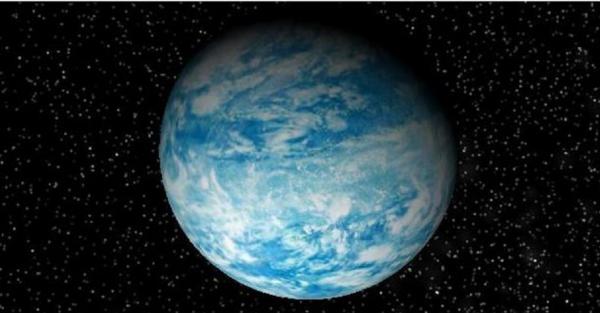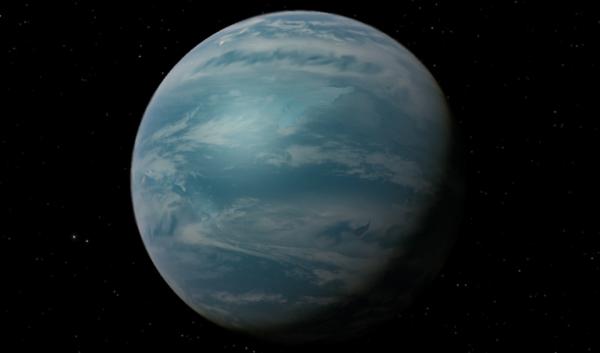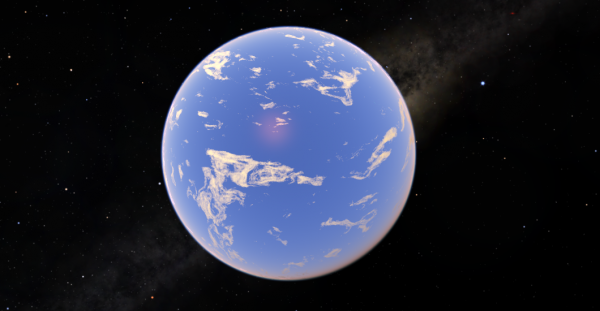BY LETTER
Panthalassic Type
Ocean planets or Waterworlds, worlds with oceans more than 50km deep | |
 Image from Steve Bowers | |
| Panthalassa, a superterrestrial waterworld | |
Superterrestrial Subtype: 2.5 to 10 earth masses
Terrestrial Subtype: 0.05-2.5 earth masses
Panthalassic worlds are temperate, moderate-sized planets with deep water oceans that have a liquid surface. Panthalassic worlds have oceans that are more than 50km deep. Water-worlds with oceans less than 50km deep are classified under the Bathypelagic subtype. Bathypelagic worlds and panthalassic worlds are both commonly referred to as ocean planets or water-worlds, and in some contexts these informal categories are expanded to include hot-water-worlds (pyrohydrothalassic) as well.
Many panthalassic worlds have a thick mantle of high-pressure ice beneath the ocean, and the depth at which this transition occurs varies significantly depending on the gravity and temperature of the world. The atmosphere of this kind of world generally has a high water vapour content, and if enough ultraviolet light is received from the local star(s), the water vapour will be split into hydrogen and oxygen, and on many panthallasic worlds the hydrogen will escape, leaving an oxygen-rich atmosphere behind. On aworld with a rocky ocean floor this oxygen will generally be absorbed into the crust, but this cannot happen on a planet where the ocean floor is covered with high-pressure ice, so the oxygen can remain in the atmosphere indefinitely.
Other gases which may be present are nitrogen, carbon dioxide (which may be largely dissolved into the ocean), argon, neon and (on the largest superterrestrial examples) helium or even hydrogen. Large ocean worlds with dense atmospheres and small neptunian worlds are often similar in many respects, and can be regarded as forming a continuous spectrum. Both planetary types include a large fraction of water or water ice, but neptunians have significantly thicker atmospheric layers. In some cases a neptunian world (or ice giant, as they are often known) may lose a significant amount of atmosphere due to atmospheric erosion or economic depletion, and become an ocean world.
Larger waterworlds are known as pyrohydrothalassic worlds; these are massive enough to retain hydrogen (and often helium is present as well), but free oxygen is not present since it reacts with the hydrogen to form water. Pyrohydrothalassic worlds have deep oceans of warm, hot or very hot water and often have a supercritical layer of water between the ocean and the atmosphere).
 Image from Steve Bowers | |
| Donbetyr, a water-world with indigenous microbial life. | |
Ocean worlds rarely support indigenous life, since the nutrients in the ocean are often quite dilute; but some hold a limited range of biota, especially where the ocean floor is geologically active and can supply essential elements for nutrition. Some lifeless waterworlds have been modified artificially to increase their capacity for supporting introduced life-forms.
 Image from Steve Bowers | |
| The terrestrial waterworld Blue in the Seams | |
Related Articles
Appears in Topics
Development Notes
Text by John M. Dollan and Steve Bowers
Initially published on 20 November 2008.
References
A New Family of Planets- Ocean Worlds
Making other Earths- Dynamical Simulations of Terrestrial Planet Formation and Water Delivery
Initially published on 20 November 2008.
References
A New Family of Planets- Ocean Worlds
Making other Earths- Dynamical Simulations of Terrestrial Planet Formation and Water Delivery
Additional Information
Isaac Arthur's YouTube video about Ocean Planets here
Ocean Planets
Ocean Planets






